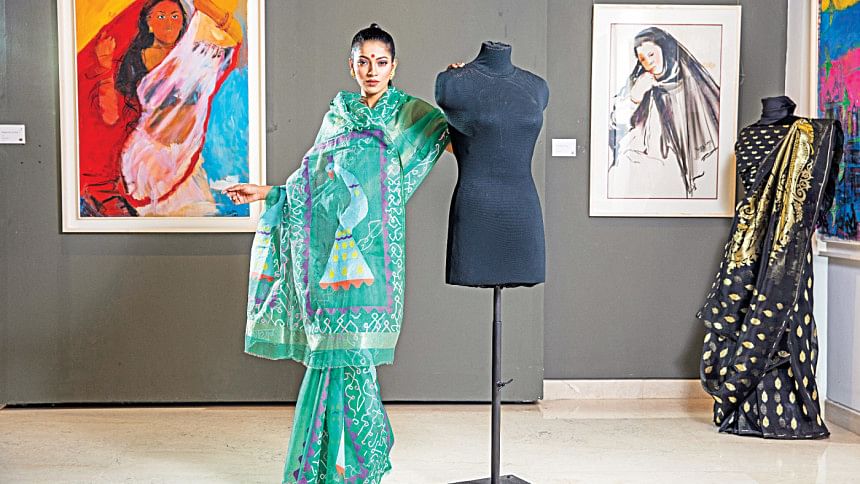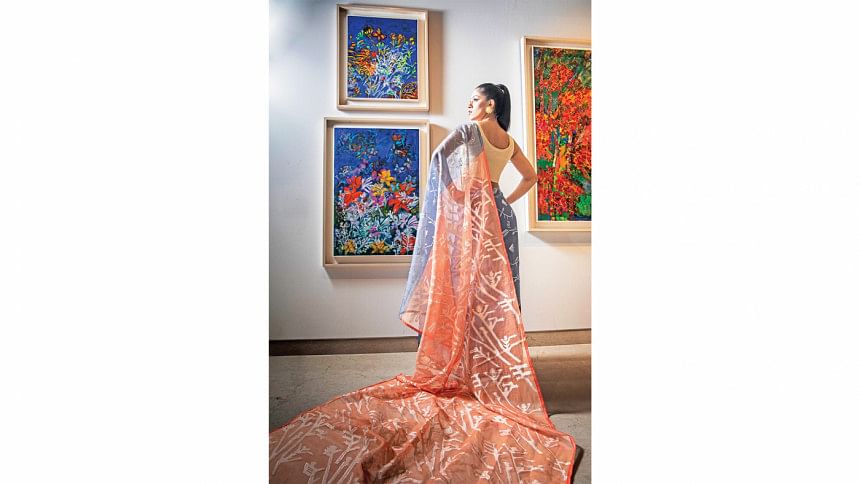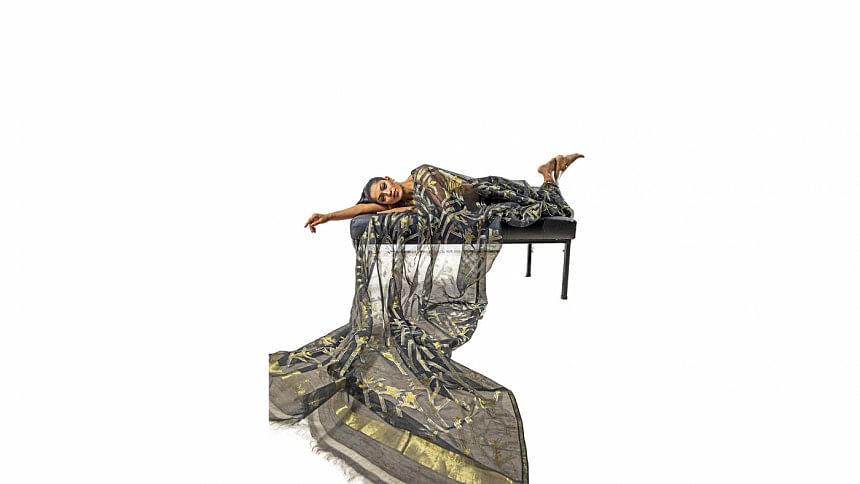Fast and slow fashion: What makes slow fashion work

The young are the typification of what's new and trending in the fast fashion world now. They are colourful and up-to-date on the latest fashion craze. They go to markets with pictures of the latest blockbuster and they buy the most trending Bollywood-inspired shalwar kameez or lehengas.
The older generation, on the other hand, is hell-bent on exclusivity in their wardrobe, and prefers to wear an elegant Tangail taant or a cotton jamdani on a casual day at work or at an elaborate dinner.
The style statements of the two genres speak volumes about their choice in clothing and there comes the great contemplation of whether to promote fast fashion, which can be categorised as inexpensive, stylish, mass-produced clothes that harm the environment or slow fashion, which are natural hand-spun and hand-woven clothes and a movement that advocates for environmental and social justice in the fashion industry.

Trendy fast fashion clothes end with the timer on which that particular vogue is running. Trends have a short shelf-life; when a new item comes to the market, people will move on to that. There is nothing wrong with sporting fast fashion. Fast fashion is inexpensive and a large number of people can sport it. These garments appeal to shoppers because they are affordable and closely follow the trend.
Meanwhile, slow fashion is the hand-spun Benarasi silk sari of our grandma's wedding trousseau. You can upcycle it or re-wear it. Slow fashion is also the canary yellow Rajshahi silk in hand-stitched nakshi kantha embroidered sari of today or the black jamdani sari in grey 'tiger's paw' motif. It can be the royal jamdani jacket, the indigo natural dye silk scarf, or a handloom, red and green, Tangail taant — slow fashion for us includes all Bangladeshi hand-spun heritage weaves and designs.
Slow fashion is stylish; it has an air of royal heritage to it. Wearing natural hand-spun and hand-woven clothes should be second nature to us. We have so much to boast about — the opulent Rajshahi silks, the fine jamdani, the Pabna sari, the gamcha, and the khadi. This is what the world is talking about now and how is it not trendy? Maybe some designs don't attract younger people but it is the designer's job to keep them fresh.
To promote clothes made with costlier slow fashion textiles for the young, who like to boast a contemporary style, designers can inject modernity into designs and cuts that are appealing to them. This way, the heritage aspect or charm of the clothing can last longer in the fashion world. Although they are pricey, slow fashion wears have a long shelf-life, while fast fashion is two new trends away from a landfill.
"A girl can wear a shuti (cotton) sari, dui fita (two belt) sandal, with a plain blouse or starched jamdani paired with a t-shirt and look like a fashionista. It is her sense of styling a simple taant or jamdani sari that becomes the style statement and it is created by the person wearing it. The trick to styling slow fashion is how she carries it. The constant changes in fashion are mostly within the fast fashion industry which dictates how you wear it. There is not much styling involved. However, slow fashion can have mass appeal too, provided it becomes somewhat affordable," states Kuhu Plamondon, artist and textile/fashion designer.
"In power looms, which run on diesel, the young boys can manage to spin two saris a day, but weavers spinning a Jamdani take a minimum of three months to complete one. How will he ensure his food and expenses if he has to wait for his sari to sell after three months? Artisans must have a salary and designated work hours and paid time off. Their art and products should be commissioned so that a designer does not have to worry about how the weavers will manage their next meal or when a customer will buy the product for him to flourish. Once his income and food are sorted, he needs to be nurtured, but sadly, no one nurtures a craftsman," she explains.
Just like pop music that catches up fast and vanishes into thin air equally fast, young people like trendy, affordable fashion that are easy to maintain. Polyesters took over mostly because it is machine washable. There is nothing wrong in it. Unfortunately, slow fashion has a niche clientele and the general populous simply can't justify spending extra for it.
"Slow fashion is my passion but it has to evolve, and designers also need to play a part; if slow fashion is made with textiles and yarns that are expensive, then only the privileged can afford it. This fashion segment then is not for everyone. Fashion on the streets has to be cheap and easy to maintain," Kuhu adds.

Haute couture may be an early example of the slow fashion movement, a one-off designer piece that becomes the pride of your wardrobe. It epitomises the principle of creating garments with both quality and longevity. For some, slow fashion couture is pricey and hard to maintain, but when you buy an expensive jamdani sari, it is a win-win investment. It's a heritage piece that can be worn and handed down to the next generation to upcycle as one desires. Its defining point is that it zeroes in on the problem of overproduction and overconsumption.
"We are flooded with junk from China, India, Pakistan; these fast fashion garments and designs will rule the market. Unless our deshi heritage weaves catering to slow fashion is commissioned by patrons and nurtured to flourish, it will die a slow and sad death," Kuhu says.
"From my days as an intern at Jim Thompson, I learned that village craft has a childlike simplicity in it. I should not enforce my knowledge, my way of organising matters, or my combination ideas onto theirs. It will kill their creativity and originality. It is a father-son tradition. When I went to the jamdani weavers to try out my Rajanigondha designs on my sari, I commissioned them and my friend Mustak Ahmed was my sponsor," she adds.
But being trendy and advocating slow fashion or fast fashion pairs with how you stylise your clothes, how you put yourself together and carry them. Slow fashion heritage weaves are forever trending; we just need to ensure that it is the choice for everyone else as well.
By RBR
Photo: Sazzad Ibne Sayed
Model: Surjo
Wardrobe: Wearable art by Kuhu Plamondon
Makeup: Orko
Styling: Sonia Yeasmin Isha

 For all latest news, follow The Daily Star's Google News channel.
For all latest news, follow The Daily Star's Google News channel. 



Comments